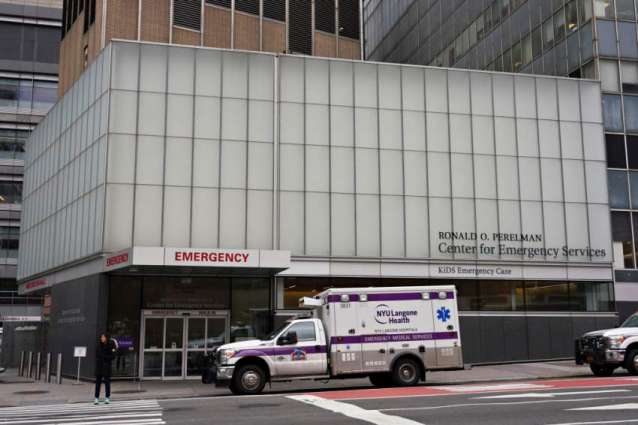Organ transplants involving living donors are down 90 percent in the United States as surgeons struggle to work amid the coronavirus outbreak, which has also made unusable body parts of those infected or killed by the disease
NEW YORK (Pakistan Point News / Sputnik - 17th April, 2020) Organ transplants involving living donors are down 90 percent in the United States as surgeons struggle to work amid the coronavirus outbreak, which has also made unusable body parts of those infected or killed by the disease.
The phenomenon highlights two different facets of the current US health crisis: On one hand, the country worst hit by the COVID-19 is fighting to save those ailing from the virus, with most hospitals banning elective, non-essential surgery to focus on the pandemic. On the other, living organ donors and their recipients are still being encouraged to proceed with transplants whenever possible, to ensure the former execute their moral responsibility and latter do not miss out on the chance to enjoy a healthier life.
"Since the beginning of March, living donor transplants have decreased very, very dramatically," David Klassen, chief medical officer at United Network for Organ Sharing (UNOS), told a webinar attended by the US transplant industry. "We now have just a few occurring each week. In most parts of the country, living donor transplantation has stopped completely."
It was relatively better with the case of deceased donors "although New York has seen a very significant decrease in donors," Klassen said, referring to the state that accounts for a third of the 30,000-plus US coronavirus deaths.
The situation has been grave enough for UNOS to issue an advisory that those on the waitlist should proceed with their transplants when possible - despite the moratorium on elective surgery by most hospitals.
Transplants are regarded as emergencies, but donors and recipients still need to come in for surgeons to perform them.
With social distancing measurements in place and hospitals being a place of high risk for contagion, it is a dilemma for both donor and recipient: Do they take maximum precaution by forgoing the procedure at hand and end up missing out on what could be done? Or do they risk going in to do the right thing, knowing there might be a risk of contagion all along?
UNOS is aware of the dilemma; thus its delicately-worded advice.
"To protect the health and safety of all involved in organ recovery and transplantation during the COVID-19 pandemic, UNOS reminds members to arrange for the surgical recovery of organs by local teams whenever possible, including by recovery surgeons who may be available within the donor hospital," the advisory issued in March said.
"This is not a requirement but has been recommended," UNOS said, adding that it was also the advice of the American Society of Transplant Surgeons, the Association of Surgical Technologists and the Association of Organ Procurement Organizations.
Klassen told the webinar he was on that "a large number of donor programs have been inactivating patients on the waitlist due to COVID-19 related issues".
FROM 600 LIVING-DONOR TRANSPLANTS A MONTH TO JUST 60
Until the COVID-19 outbreak, there were typically about 600 organ transplants involving living people performed each month in the United States, according to data published by UNOS, a private non-profit organization that manages the US organ transplant system.
But this year, after averaging 584 living donor transplants in both January and February, that trend suddenly halved to 274 by March 15 as thousands of coronavirus cases began popping in the United States daily, and most of the country went into lockdown to stem the outbreak.
By March 31, there were just another 60 living donor transplants. From around 20 such transplants a day at the start of the year, there were just about four daily as the first quarter ended.
The decline has gotten worse since, with only 26 living donor transplants recorded in the first 13 days of April - an average of two a day. That's a 90 percent collapse from the January-February average.
DECEASED-DONOR TRANSPLANTS DOWN 70%
UNOS did not break out data on COVID-19 victims who were registered as organ donors but could not go through the process because of their infection.
But it said that before the pandemic accelerated in the United States, there were an average of 194 deceased-donor transplants a day in February, and this fell to 82 a day in March and just 60 daily by April. Between the highs and lows of this year, that constituted a 70 percent drop.
"The number of deceased-donor kidney transplants and heart transplants decreased by about 40 percent," Klassen said. "Liver transplants have decreased by about a third while lung transplant is down by about 60 percent."
The Transplantation Society, which is dedicated to assisting organ donorship worldwide, said hospitals in New York and San Francisco - another US COVID-19 hotspot - were struggling to perform transplant under onerous circumstances.
"We have performed [transplants on] one heart, one lung, three livers and five kidneys in the past week," it said. "This is not likely to be sustained, all clinic activities have been virtualized. We have tested 76 patients at our center with some 20 COVID-19 positive results. One lung transplant patient is currently critically ill."
The group said quite a few of its staff have been exposed to the virus and several of them had taken ill. They have also virtualized the inpatient rounds and minimized the team numbers in the hospital at any time.
Operating rooms have scaled down to two-person Intensive Care Units and experiments were being carried out with double ventilation from a single machine to double ICU capacity.
"Transplants are still considered emergencies but we are having fewer donors though there are seven active donor cases right now in the system. But that referral to the Organ Procurement Organization is slowing down as the regional hospitals are becoming overwhelmed," the report said. "It appears likely that transplant will be subsumed by the broader public health efforts, depending on the slope of the new cases curve. But so far, we are tracking projections that are about four weeks away from the peak."
On the situation in San Francisco, The Transplantation Society said it was continuing to perform deceased-donor liver and kidney transplants, but not pancreas transplants. Deceased-donor testing is done on all potential lung donors and "as indicated" by clinical circumstances.
They continue to perform live donor kidney and liver transplants, hoping to have preoperative testing of pairs soon, the society said.




